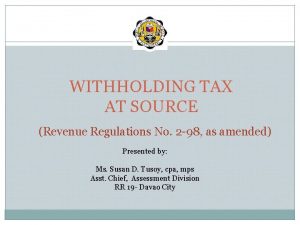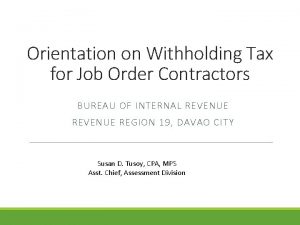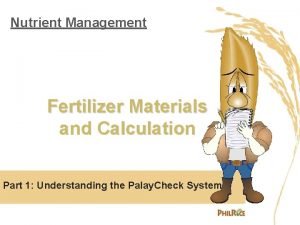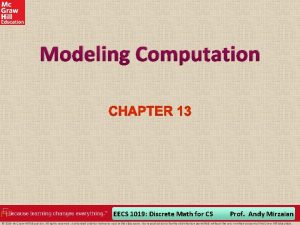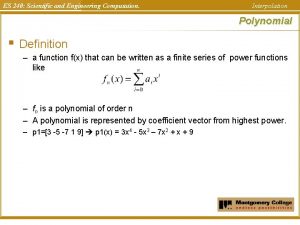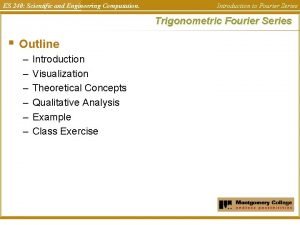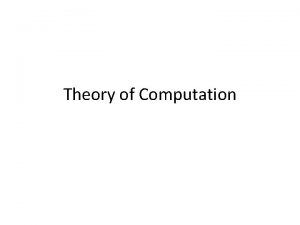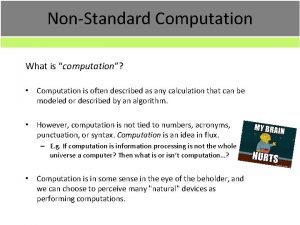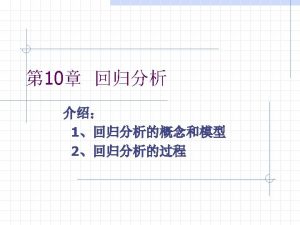ES 240 Scientific and Engineering Computation Chapter 6
















- Slides: 16

ES 240: Scientific and Engineering Computation. Chapter 6 Uchechukwu Ofoegbu Temple University Chapter 6: Roots: Open Methods

ES 240: Scientific and Engineering Computation. Chapter 6 Open Methods § Open methods versus bracketing methods: – Open methods require only a single starting value or two starting values that do not necessarily bracket a root. – Open methods may diverge as the computation progresses – When open methods do converge, they usually do so much faster than bracketing methods.

ES 240: Scientific and Engineering Computation. Chapter 6 Graphical Comparison of Methods a) b) c) Bracketing method Diverging open method Converging open method - note speed!

ES 240: Scientific and Engineering Computation. Chapter 6 Simple Fixed-Point Iteration § § § Rearrange the function f(x)=0 so that x is on the left-hand side of the equation: x=g(x) Use the new function g to predict a new value of x – xi+1=g(xi) The approximate error is given by:

ES 240: Scientific and Engineering Computation. Chapter 6 Example § § Solve f(x)=e-x-x Re-write as x=g(x) by isolating x (example: x=e-x) Start with an initial guess (e. g, 0) Continue until some tolerance is reached i xi | a| % | t|i/| t|i-1 0 0. 0000 1 1. 0000 100. 000 76. 322 0. 763 2 0. 3679 171. 828 35. 135 0. 460 3 0. 6922 46. 854 22. 050 0. 628 4 0. 5005 38. 309 11. 755 0. 533 100. 000

ES 240: Scientific and Engineering Computation. Chapter 6 Convergence § Convergence of the simple fixedpoint iteration method requires that the derivative of g(x) near the root has a magnitude less than 1. – – Convergent, |g’|<1 Divergent, |g’|>1

ES 240: Scientific and Engineering Computation. Chapter 6 Newton-Raphson Method § Based on forming the tangent line to the f(x) curve at some guess x, then following the tangent line to where it crosses the x-axis. § It converges very fast for most functions

ES 240: Scientific and Engineering Computation. Chapter 6 Newton-Raphson Method - Example § Use the Newton-Raphson Method to find the root(s) of the function: – Find the derivative – Use the newt-raph function

ES 240: Scientific and Engineering Computation. Chapter 6 Secant Methods § Problem with the Newton-Raphson method – You have to evaluate the derivative – there are certain functions whose derivatives may be difficult or inconvenient to evaluate. § Solution – Approximate the derivative using the backward finite divided difference:

ES 240: Scientific and Engineering Computation. Chapter 6 Secant Methods (cont) § Substitution of this approximation for the derivative to the Newton-Raphson method equation gives: § Note - this method requires two initial estimates of x but does not require an analytical expression of the derivative.

ES 240: Scientific and Engineering Computation. Chapter 6 MATLAB’s fzero Function § MATLAB’s fzero provides the best qualities of both bracketing methods and open methods. – Using an initial guess: x = fzero(function, x 0) [x, fx] = fzero(function, x 0) function is the name of the function being evaluated x 0 is the initial guess x is the location of the root fx is the function evaluated at that root – Using an initial bracket: x = fzero(function, [x 0 x 1]) [x, fx] = fzero(function, [x 0 x 1]) • As above, except x 0 and x 1 are guesses that must bracket a sign change • •

ES 240: Scientific and Engineering Computation. Chapter 6 fzero Options § Options may be passed to fzero as a third input argument the options are a data structure created by the optimset command § options = optimset(‘par 1’, val 1, ‘par 2’, val 2, …) – parn is the name of the parameter to be set – valn is the value to which to set that parameter – The parameters commonly used with fzero are: • display: when set to ‘iter’ displays a detailed record of all the iterations • tolx: A positive scalar that sets a termination tolerance on x.

ES 240: Scientific and Engineering Computation. Chapter 6 fzero Example § Use fzero to find roots of f(x)=x 10 -1 starting with an initial guess of x=0. 5. § You could also set the options to display iterations: § options = optimset(‘display’, ‘iter’); – Sets options to display each iteration of root finding process § [x, fx] = fzero(@(x) x^10 -1, 0. 5, options) – Uses fzero to find roots of f(x)=x 10 -1 starting with an initial guess of x=0. 5. § MATLAB reports x=1, fx=0 after 35 function counts

ES 240: Scientific and Engineering Computation. Chapter 6 Polynomials § § MATLAB has a built in program called roots to determine all the roots of a polynomial - including imaginary and complex ones. x = roots(c) – x is a column vector containing the roots – c is a row vector containing the polynomial coefficients § Example: – Find the roots of f(x)=x 5 -3. 5 x 4+2. 75 x 3+2. 125 x 2 -3. 875 x+1. 25 – x = roots([1 -3. 5 2. 75 2. 125 -3. 875 1. 25])

ES 240: Scientific and Engineering Computation. Chapter 6 Polynomials (cont) § MATLAB’s poly function can be used to determine polynomial coefficients if roots are given: – b = poly([0. 5 -1]) § • Finds f(x) where f(x) =0 for x=0. 5 and x=-1 • MATLAB reports b = [1. 000 0. 5000 -0. 5000] • This corresponds to f(x)=x 2+0. 5 x-0. 5 MATLAB’s polyval function can evaluate a polynomial at one or more points: – a = [1 -3. 5 2. 75 2. 125 -3. 875 1. 25]; • If used as coefficients of a polynomial, this corresponds to f(x)=x 53. 5 x 4+2. 75 x 3+2. 125 x 2 -3. 875 x+1. 25 – polyval(a, 1) • This calculates f(1), which MATLAB reports as -0. 2500

ES 240: Scientific and Engineering Computation. Chapter 6 Lab § Ex 6. 4 a&b – Do this step by step in Matlab
 Information gathered during an experiment
Information gathered during an experiment How is a scientific law different from a scientific theory?
How is a scientific law different from a scientific theory? Tera in scientific notation
Tera in scientific notation Contoh engineering/scientific software
Contoh engineering/scientific software Scientific method vs engineering design process
Scientific method vs engineering design process Scientific method vs engineering design process
Scientific method vs engineering design process Convert 240 k and 468 k to the celsius scale
Convert 240 k and 468 k to the celsius scale Forward engineering and reverse engineering
Forward engineering and reverse engineering Withholding tax on compensation computation
Withholding tax on compensation computation Expanded withholding tax computation
Expanded withholding tax computation Expanded withholding tax computation
Expanded withholding tax computation Job order tax
Job order tax Fertilizer computation examples
Fertilizer computation examples Eecs 1019
Eecs 1019 Sipser, m: introduction to the theory of computation
Sipser, m: introduction to the theory of computation Computation of mcit
Computation of mcit Income tax computation format
Income tax computation format









